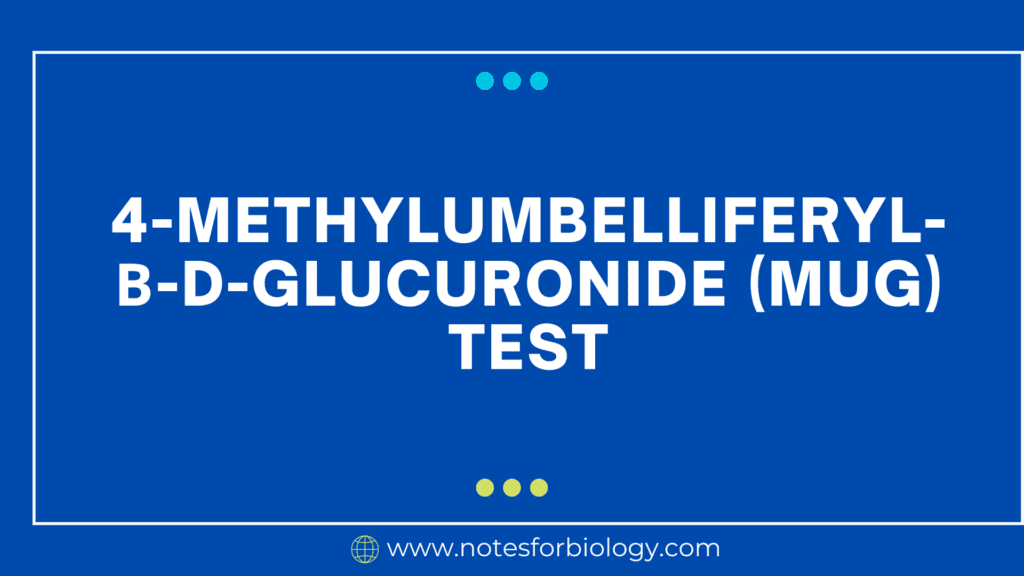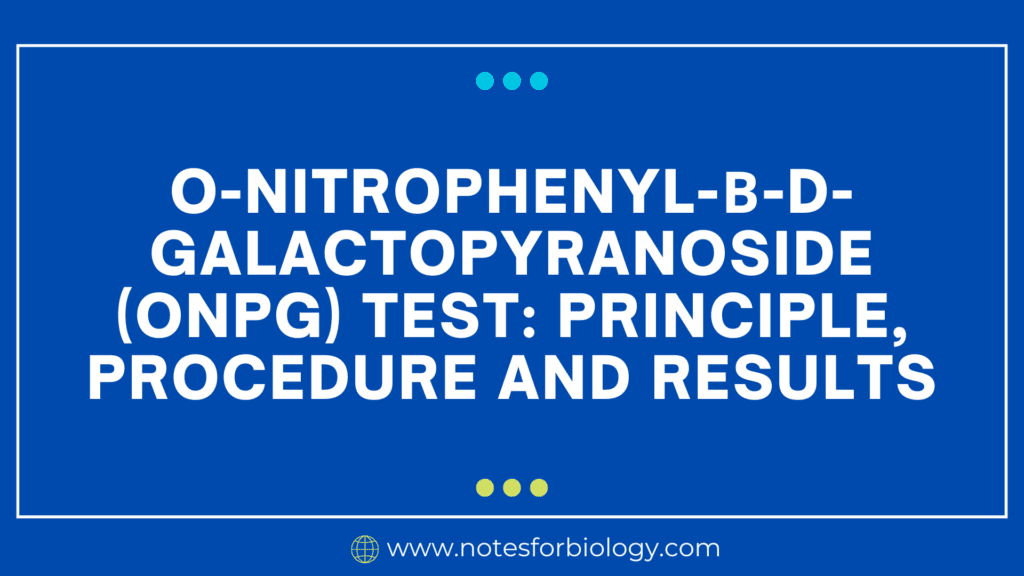4-Methylumbelliferyl-β-D-Glucuronide (MUG) test is a biochemical assay used to detect the enzyme β-glucuronidase, which is produced by certain bacteria, notably Escherichia coli (E. coli). This test is commonly used in microbiological water testing and food safety to identify E. coli as an indicator of fecal contamination.
Table of Contents
4-Methylumbelliferyl-β-D-Glucuronide Test
The 4-Methylumbelliferyl-β-D-Glucuronide test (MUG) is a biochemical assay that is utilized to identify the existence of the β-glucuronidase enzyme, which is generated by specific bacteria, primarily Escherichia coli (E. coli). This test is frequently used to detect E. coli, a sign of fecal contamination, in microbiological water testing, food safety, and clinical diagnostics.

Principle
The β-glucuronidase enzyme hydrolyzes 4-Methylumbelliferyl-β-D-Glucuronide, which forms the basis of the MUG test protocol. The production of β-glucuronidase by E. coli hydrolyzes MUG to yield 4-methylumbelliferone when the bacteria is present in a sample. It is simple to identify E. coli thanks to this compound’s fluorescence under ultraviolet (UV) light.
Procedure
Materials Needed:
- MUG substrate (4-Methylumbelliferyl-β-D-Glucuronide)
- Bacterial culture or environmental sample
- Growth medium (e.g., nutrient broth)
- Incubator set at 35-37°C
- UV light source
Procedure:
Sample Setting Up:
Introduce the bacterial culture or material that you think may include E. coli into the growing medium.
MUG addition:
To the growing medium that has been infected, add the MUG substrate.
Embryology
The mixture should be incubated for 4–24 hours at 35–37°C. Depending on the methodology and bacterial concentration, the precise incubation period may change.
Note:
Check for fluorescence in the mixture by shining a UV light source on it after it has been incubated.
Results Interpretation

Positive Result:
- Look: Fluorescence when exposed to UV radiation.
- Interpretation: The presence of the enzyme β-glucuronidase indicates the presence of E. coli in the sample.
Negative Result:
- Aspect: In the presence of UV radiation, no fluorescence.
- Interpretation: The lack of β-glucuronidase enzyme suggests that either very little or no E. coli is present in the sample.
Applications
- Water testing: As a sign of fecal contamination, E. coli is frequently found in drinking water, recreational water, and wastewater using the MUG test.
- Food Safety: To make sure a variety of food products are safe to eat, it is used to test for E. coli infection.
- Clinical Diagnostics: The MUG test is used in clinical settings to detect E. coli in patient samples, which facilitates the diagnosis of illnesses.

Limitations
- Specificity: Although the MUG test has a high degree of specificity for E. coli, certain strains are not β-glucuronidase producers, which could lead to false-negative results. There are a few different microorganisms that can cause false-positive results that generate β-glucuronidase.
- Sensitivity: Low bacterial numbers may result in insufficient enzyme production for detection, compromising the test’s sensitivity.
- Incubation Period: Samples with low bacterial counts may need longer incubation periods, which could cause the findings to be delayed.
Frequently Asked Question
What is 4-Methylumbelliferyl-β-D-Glucuronide Test ?
4-Methylumbelliferyl-β-D-Glucuronide test is a biochemical assay used to detect the enzyme β-glucuronidase, which is produced by certain bacteria, notably Escherichia coli (E. coli). This test is commonly used in microbiological water testing and food safety to identify E. coli as an indicator of fecal contamination.
What is the purpose of the 4-Methylumbelliferyl-β-D-Glucuronide Test test?
The 4-Methylumbelliferyl-β-D-Glucuronide test aims to identify the enzyme β-glucuronidase, which is produced by Escherichia coli, in order to determine the presence of the bacteria. For food safety, clinical diagnostics, and microbiological water testing, this test is essential. By finding E. coli in drinking water, recreational water, and wastewater, it aids in the identification of fecal contamination in water testing.
What is the MUG method for E. coli?
The MUG method for E. coli detection involves using the substrate 4-Methylumbelliferyl-β-D-Glucuronide (MUG) to identify the presence of the enzyme β-glucuronidase, which is produced by E. coli.
Related Article




